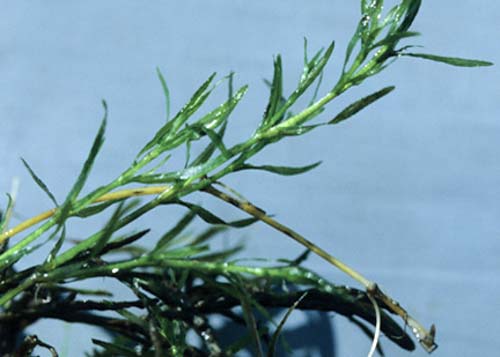Southern Naiad
Southern naiad (Najas guadalupensis) will increase growth and begin to top out during summer. Reaching the surface, the plant will begin to flower and continue to bloom through fall. The brittle nature of the plant makes punching easy.

Seasonal Techniques
Spring—Like most native annual plants, southern naiad will begin to emerge in late April or early May. Try a rattle-trap, big swim bait or Carolina rig that will float just above emerging plants. These plants grow in clumps, so fishing the open areas between plants is a good bet.
Summer—Southern naiad will increase growth and begin to top out during summer. Reaching the surface, the plant will begin to flower and continue to bloom through fall. The brittle nature of the plant makes punching easy.
Fall—Competition for space with invasive plants will leave southern naiad confined to shallow depths and areas void of other species. Southern naiad often hangs around slightly longer than some of the other native pondweeds and naiads. Key in on places where southern naiad and other species were intermixed in summer and try flipping into southern naiad growing shallower inside larger milfoil and hydrilla mats.
Winter—Southern naiad will die completely back, leaving only seed behind.
Habitat Value
Fish—N/A
Waterfowl—Waterfowl extensively use southern naiad as food and the whole plant can be consumed, and parts are utilized by diving, dabbling, whistling ducks, many types of geese, swans and coots.
Identifying Features
What It Looks Like—Like other naiads, leaves are opposing and submersed. Southern naiad leaves are typically shorter than similar-looking pondweed species.
Where to Find It—Southern naiad can be found in a wide variety of places. In areas where invasive plants like hydrilla and milfoil aren’t present, this plant can do well. Look in shallow water areas void of these other species.
Max Depth—0 to 5 feet
Similar Species—Slender and sago pondweeds look similar, but their leaves are alternating whereas southern naiad leaves are opposing. Brittle naiad is much more bushy in appearance and leaves have apparent teeth along their edges.
Drawbacks
Southern naiad can grow to nuisance levels causing water use problems, and can be very difficult to manage. Cost to manage: $$$ out of $$$$$.
Contact Us
We're always looking for more information about aquatic plants on TVA reservoirs. Let us know where and what you see, and send us your photos. Email us.